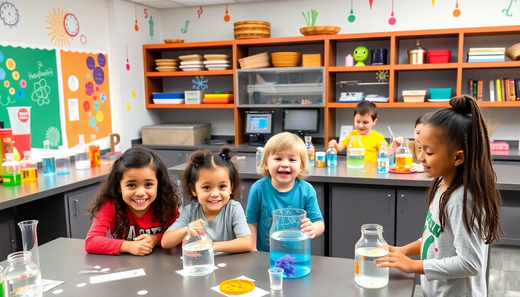
8 Simple Science Experiments for Visual Learning in Neurodiverse Kids
Share
As a parent of a neurodiverse child, I know firsthand the importance of finding engaging, hands-on ways to support their learning. Traditional teaching methods don't always resonate with kids who process information differently, which is why I'm excited to share eight simple science experiments that can ignite a love of STEM in visual learners.
These experiments are perfect for homeschooling, classroom settings, or just exploring science at home. They're designed to be easy to set up, use common household materials, and provide a multisensory experience that can help cement new concepts. So, let's dive in and discover the wonders of science together!
The Baking Soda and Vinegar Volcano
This classic experiment is a crowd-pleaser for a reason. By combining baking soda and vinegar, kids can witness a dramatic chemical reaction that produces a foaming "eruption." Not only is it visually captivating, but it also teaches important scientific principles like chemical reactions and the release of carbon dioxide.
To set up the volcano, you'll need a plastic bottle or container, baking soda, vinegar, and food coloring (optional). Start by adding a few tablespoons of baking soda to the container, then slowly pour in the vinegar. Watch as the mixture bubbles and overflows, creating a mesmerizing display. You can even add a few drops of food coloring to the vinegar to make the "lava" more vibrant.
Floating Eggs
This experiment is a great way to explore density and buoyancy. All you need are eggs, water, and salt. Begin by placing an egg in a glass of water. Observe how it sinks to the bottom. Next, add a few tablespoons of salt to the water and stir until it dissolves. Carefully place the egg back in the glass, and watch as it begins to float!
The salt increases the density of the water, making it more buoyant. This allows the egg, which is denser than regular water, to float. Kids can experiment with different amounts of salt to see how it affects the egg's behavior, fostering a deeper understanding of density and its role in buoyancy.
Milk Rainbow
This experiment is a visual feast, as it allows kids to witness the separation of colors in milk. You'll need milk, food coloring, and a shallow dish or plate.
Start by pouring a small amount of milk into the dish. Then, add a few drops of different food coloring (red, blue, and yellow work well) around the edges of the dish. Observe as the colors slowly diffuse and blend, creating a mesmerizing rainbow effect.
This experiment demonstrates the principle of density differences, as the food coloring sinks through the milk at different rates, creating the rainbow pattern. It's a great way to introduce the concept of chromatography and the properties of light.
Balloon Rocket
Get ready for some high-flying fun with this balloon rocket experiment. You'll need a balloon, a straw, and some tape.
Inflate the balloon and hold the end closed. Tape the straw to the balloon, making sure it's securely in place. Then, release the balloon and watch it soar across the room! This experiment showcases Newton's third law of motion, as the air rushing out of the balloon provides the thrust to propel it forward.
Kids can experiment with different balloon sizes, straw placements, and inflation levels to see how it affects the rocket's performance. This hands-on activity is sure to spark their curiosity about the physics of motion and propulsion.
Oobleck
Oobleck is a fascinating non-Newtonian fluid that behaves both as a solid and a liquid. To create it, you'll need cornstarch and water.
Start by adding a few cups of cornstarch to a large bowl. Slowly add water, stirring constantly, until the mixture reaches a thick, gooey consistency. Encourage your child to poke, squeeze, and manipulate the Oobleck, observing how it reacts.
When pressure is applied, Oobleck behaves like a solid, but when the pressure is released, it reverts to a liquid state. This unique property can captivate kids and lead to discussions about the states of matter, molecular structure, and the science behind non-Newtonian fluids.
Lava Lamp
Bring the 1960s into your home with a homemade lava lamp experiment. You'll need vegetable oil, water, food coloring, and Alka-Seltzer tablets.
Start by filling a clear bottle or container with vegetable oil, leaving a few inches of space at the top. Add a few drops of food coloring, then carefully pour in water until it reaches the top of the oil layer. Break an Alka-Seltzer tablet in half and drop the pieces into the mixture.
As the tablet reacts with the water, it will release bubbles that rise through the oil, creating a mesmerizing lava lamp effect. Kids can experiment with different food coloring combinations, oil-to-water ratios, and tablet sizes to see how it affects the final result.
This experiment is a great way to explore density differences, chemical reactions, and the properties of liquids.
Elephant Toothpaste
Get ready for a foamy explosion with the elephant toothpaste experiment. You'll need hydrogen peroxide, dish soap, food coloring, and potassium iodide (or yeast).
Start by pouring a small amount of hydrogen peroxide into a bottle or container. Add a few drops of dish soap and food coloring, then sprinkle in the potassium iodide (or a packet of yeast). Stand back and watch as the mixture rapidly expands, creating a colorful, foamy eruption that resembles toothpaste.
This experiment demonstrates an exothermic reaction, where the decomposition of hydrogen peroxide releases heat and oxygen gas, causing the dramatic foam explosion. It's a visually captivating way to teach kids about chemical reactions, catalysts, and the release of energy.
Density Layers
Explore the concept of density with this mesmerizing density layers experiment. You'll need a clear container, water, vegetable oil, food coloring, and a few other household items.
Begin by filling the container with water, leaving a few inches of space at the top. Add a few drops of food coloring to the water. Next, carefully pour vegetable oil into the container, creating a distinct layer on top of the water. You can experiment with different liquids, such as honey or corn syrup, to create additional layers.
As the liquids settle, kids can observe how they form distinct layers based on their density. This experiment is a great way to introduce the concept of density and how it affects the behavior of different substances.
Conclusion
These eight science experiments are just the tip of the iceberg when it comes to engaging, hands-on learning for neurodiverse kids. By tapping into their visual and kinesthetic learning styles, you can foster a love of STEM subjects and help them develop important critical thinking and problem-solving skills.
Remember, the key to making these experiments successful is to create a safe, supportive environment where kids feel empowered to explore, experiment, and learn at their own pace. Encourage them to ask questions, make observations, and draw their own conclusions. With a little creativity and a lot of curiosity, these simple science experiments can open up a world of wonder and discovery for your neurodiverse learner.
So, gather your materials, set up your experiments, and get ready to dive into the fascinating world of science together. Happy exploring!
